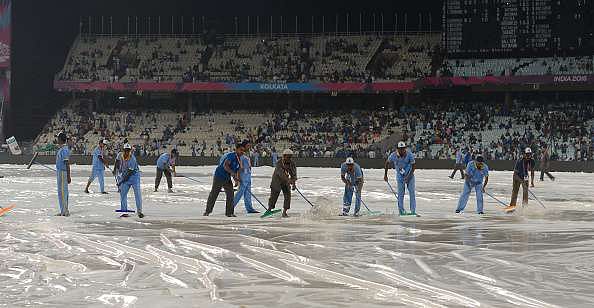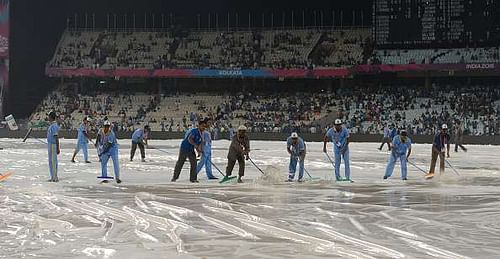
SK Glossary - What is the Duckworth-Lewis (D/L) System?
Twenty-two runs to score, one ball left. The image of that (in)famous scorecard from the 1992 World cup semi-final between England and South Africa lingers on in many a cricket fan's minds. A preposterous rain rule changed the target from a gettable 22 off 13 to "that" score and condemned the Proteas to a heartbreaking semi-final defeat in their first ever World Cup post readmission. After the debacle, and the outrage in the Media along with it, the ICC conceded that a change was needed so as to avoid such embarrassing situations in rain affected matches, which led to the invention of the Duckworth-Lewis System.
So what is this?
The brainchild of two British statisticians, Frank Duckworth and Tony Lewis, the Duckworth-Lewis (D/L) system was a result of the England-South Africa Match. Citing the reason, Duckworth explained, “I recall hearing Christopher Martin-Jenkins on the radio saying 'surely someone, somewhere could come up with something better' and I soon realized that it was a mathematical problem that required a mathematical solution.” They surely came up with one and the D/L system was born.
To put it simply, it is a method to set a fair target for the team batting second (T2), taking into account the runs scored, overs played and wickets lost by the team batting first (T1). The target for T2 is adjusted up or down from that T1, in proportion to the wickets and overs available.
Method
Teams are still confounded at times with the D/L system, with par (to tie) and winning scores changing at the fall of every wicket or completion of every over. We'll try to simplify things for our readers.
Par score for T2 = T1's score x (T2's resources/T1's resources)
(Resources here refers to overs and wickets available)
The system has two editions, namely Standard Edition and Professional Edition. The Professional Edition is the one used in all International and First-class games as the complex calculations of available resources require the use of a computer program and are not publicly available.
As it would usually occur, if this par score is a non-integer(decimal) number of runs, then T2's winning score is rounded up to the next integer. Let us consider an example:
If T2 has only 80% of the resources that were available to T1 and T1 scored 232 runs, then the winning score for T2 will be 232 x 80% = 185.6, which will be rounded off to 186; setting a par score of 185.
In case, in a 50 over match, T1 completed an uninterrupted innings, it would mean they had 100% resources available to them. Thus, the formula would ease out to:
Par score for T2 = T1's score x T2's resources
Impact on T2's target
If a delay occurs before the start of the first innings and the number of overs is reduced, then D/L system will not be applicable. This is because both teams will have the same number of wickets and overs available and will know this throughout their innings.
In the case interruptions occur in T1's innings so that the number of overs in the two innings are reduced but kept the same for both teams, then D/L system will adjust the score for T2 as described above. The adjustments made to T2's target in such a case is considering the fact that T2 would have more resources available than T1 had.
Funnily, we see at times that the target for T2 is much higher than the score actually set by T1 after interruptions. The explanation is simple, that for some of their innings, T1 would have thought they have more overs than they actually faced. They would have batted less conservatively and scored more runs of they had known they would have lesser overs to face. Thus, they saved up on resources to have a late dash. Since those overs got canceled and T2 has got more resources to use in the same number of overs; the target score for T2 is compensated considering the denial of some of the overs that T1 might have got to bat.
In the case of interruptions before or during T2's innings, then T2's target is reduced in proportion to T2's reduced resources. In the case of multiple interruptions, the target is lowered accordingly each time.
In the odd situation where interruptions both increase and decrease the target score, the net effect of D/L system could be an increase or decrease, depending on which interruptions were bigger.
Famous cases
During the fifth ODI between India and South Africa in January 2011, rain halted play twice during the first innings, resulting in a reduction of the match to 46 overs for each side. South Africa scored 250/9 and the D/L method was applied which adjusted India's target to 268. As explained above, since the overs were reduced during the first innings, the D/L score took into account what the Proteas were likely to have scored if they had known that the match was only 46 overs long throughout their innings.
Another case involving South Africa (RSA) was in the 2003 world cup which was hosted by them. Playing against Sri Lanka (SRL) in a must-win game, South Africa had to chase 269 from their 50 overs. They had reached 229/6 from 45 overs when play was abandoned due to rain. Mark Boucher played out 5 deliveries of the 45th over thinking that 229 was enough to get them through.
But as explained in the methods, he turned out to be wrong.
RSA was deemed to have used 85.7% of their available resources while SRL had used 100%
Thus, the target score was set to 268 x 85.7% = 229.7; rounded off to 230 as a winning score.
Had the last delivery of the 45th over not been bowled, then RSA would have used 85.3% of their resources of overs and wickets, setting them a target score of 268 x 85.3% = 228.6; rounded off to 229, awarding them a win.
Criticism and controversy
The system has been criticized widely stating that it gives much more emphasis on wickets than on overs while calculating available resources. This leads to chasing teams looking not losing wickets in a match where there is a probability of rain and scoring at a less than required run rate to remain ahead of the D/L par score.
Also, it does not consider the field restrictions (no. of players outside the 30-yard circle) when calculating par scores. This leads to unfair par scores.
Recently, concerns have been raised as to how suitable the method is for the fast-paced T-20 format of the game where one very high scoring over can drastically alter the par scores.
Revisions
Prior to the 2003 world cup, only the Standard edition was in used. Post this world cup, the Professional edition was developed considering all the variations that could come in while calculating remaining resources for T2.
In early 2015, the method was renamed to Duckworth-Lewis-Stern (D-L-S) method. This is to acknowledge the contribution of Stern Software towards calculation if par score and resources.
